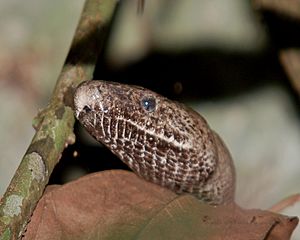Puerto Rican boa facts for kids
Quick facts for kids Puerto Rican boa |
|
|---|---|
 |
|
| Conservation status | |
| Scientific classification | |
| Genus: |
Chilabothrus
|
| Species: |
inornatus
|
| Synonyms | |
The Chilabothrus inornatus, also known as the Puerto Rican boa, is a large snake found only on the island of Puerto Rico. Locals call it culebrón, meaning 'big snake', or boa puertorriqueña. Even though it's sometimes called the "yellow tree boa," it's actually dark brown and lives on the ground, not in trees.
This boa can grow up to 1.9 m (6.2 ft) long. It eats small mammals like rodents and bats, birds, and sometimes anole lizards. Like all boas, it gives birth to live young (it's viviparous) and squeezes its prey to kill it, a method called constriction.
Contents
What's in a Name? (Taxonomy)
For a long time, this snake was known as Epicrates inornatus. But in 2013, scientists decided to move it to a different group, or genus, called Chilabothrus. So now its full scientific name is Chilabothrus inornatus.
The word epicrates comes from Ancient Greek and means 'powerful'. The word inornatus comes from Latin and means 'unadorned' or 'plain'. So, its old name meant 'powerful plain boa'.
How to Spot a Puerto Rican Boa (Description)
The Puerto Rican boa can grow to be about 1.9 m (6.2 ft) long, but some can reach up to 2.7 m (8.9 ft). Its scales on top of its head, called parietal scales, are uneven.
Their colors can be different. Some are a deep, dark brown, while others are more of a chestnut brown. Their bellies can be dark gray or a lighter slate-brown. Some boas have faint dark patterns like cross bars or spots, while others have very few markings. Their eyes are usually a silvery-gray color.
Similar Snakes
Puerto Rico doesn't have many types of snakes. The Puerto Rican boa is the largest by far. Another similar snake in the area is Epicrates monensis. You can tell them apart by looking at the scales above their eyes (supraocular scales). In the Puerto Rican boa, these scales are about one-third as wide as the main scale on its forehead (frontal scale). In Epicrates monensis, they are about half as wide.
Where They Live (Distribution)
The Puerto Rican boa is found only on the island of Puerto Rico. This means it is endemic to Puerto Rico.
Life in the Wild (Ecology)
Habitat
You can find these boas in wooded and rocky areas, especially in the foothills. They are more common in the northwest part of the island and in the karst regions, which are areas with unique limestone formations and caves along the northern coast.
What They Eat (Diet)
The boa is a "sit-and-wait" predator. This means it waits for its prey to come close instead of actively hunting it down. It hunts at night and mostly stays on the ground, not often climbing trees.
When it catches prey, it grabs it with its jaws, then wraps its body around the animal. It squeezes tighter and tighter until the prey can't breathe. Then, it swallows the prey headfirst.
Adult boas mostly eat mammals like mice, rats, and bats. Birds are also a part of their diet. Young boas might eat small lizards like anoles and possibly geckos.
Because they live in areas with many caves, Puerto Rican boas often eat bats. They hang at the entrance of caves and wait for bats to fly out. When a bat comes by, the boa quickly grabs it and then squeezes it.
How They Reproduce (Reproduction)
Female Puerto Rican boas give birth to live young. A pregnant female can have about 23 to 26 baby boas at a time.
Protecting the Puerto Rican Boa (Conservation)
Long ago, the Puerto Rican boa was very common. People even used oil from the snake's fat to sell to other countries. This, along with lots of trees being cut down, caused the boa's numbers to drop. By the early 1900s, there wasn't much natural forest left.
Some people thought that mongooses, which were brought to Puerto Rico in the 1800s, also hurt the boa population. However, there's no clear proof of this.
In the early 1900s, the snake was quite rare. But after the island's economy changed and many forests grew back, the boa's numbers seem to have recovered a bit. Still, they are not out of danger yet. To help protect them, a special conservation area has been set up for them in Bosque Estatal San Patricio in Guaynabo.
Images for kids
See also
 In Spanish: Boa de Puerto Rico para niños
In Spanish: Boa de Puerto Rico para niños



